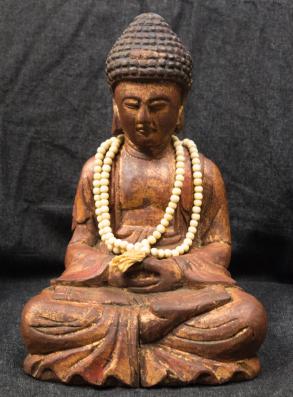Meditation Techniques

Awareness Cultivation/Zazen
Zazen, as it is known in the Japanese Zen tradition, is the practice of “just sitting in mindfulness.” It is not a matter of “stopping” the mind, but rather allowing the practitioner to become aware of his or her own thoughts, so that benefit can be had from a more intimate awareness of one’s present condition. The practice of sitting meditation allows for a relaxation and deep calm to result in the practitioner. The simple attention that results from just sitting allows for a nonjudgmental awareness of one’s circumstances, so that fewer negative mental labels are attached to one’s experiences “out in the world.” The practice of just sitting is most beneficial because it is readily employable in stressful situations in one’s everyday life. As you sit, simply "watch and be present." [NOTE: If you have difficulty with zazen, try placing a tea candle in front of you for an object of focus.]
Breathing
As in all seated meditations, the practitioner should first situate him or herself in a proper meditation posture that is centered and balanced. The spine should be upright and centered over the meditation cushion, and the legs should be in an appropriate position to maximize comfort (seiza, half-lotus, Burmese style, and chair are the recommended options). This meditation exercise focuses one’s awareness on the breath, and in particular, the rhythmic nature of the inhalations and exhalations. This meditation is facilitated by the use of a wooden fish drum, or two blocks of wood, which are brought together to initiate each inhalation and exhalation. As the meditation progresses, the practitioner should feel the bodymind relaxing and entering a deeper calm, and the breathing cycles should become prolonged. You may purchase two cheap blocks of wood from a local hardware store for this meditation practice. There are also smartphone apps available which will play wood block or fish drum sounds for you.
Bell Meditation
This meditation may be performed alone or in a group setting. The leader strikes a “ching” (Chinese bowl bell), and the audible sound of the bell is focused on entirely by the practitioners. The practitioner’s mind should follow the sound from its initial pronounced strike to its fading away into quietude. After the sound is extinguished fully, the leader strikes the bell again, and this is continued to comfort and benefit. You may also download our "Bell Meditation" MP3 file or use a smartphone application for your personal practice.
Mantra ("AUM")
All mantra meditations involve the slow repetition of a short sound, syllable, word or statement. The mantra practice is ideal when it incorporates a basic, resonating sound that is easily controlled by the outward breath. A traditional and ideal choice is “AUM,” also written as “OM,” for these reasons. This particular sound is thought to be the most basic of all sounds in traditional Indian philosophy and meditation practice. It is chanted very slowly, and the mouth is opened wide for the initial “Aaaaa,” and slowly constricted as the sound is continued through the outward breath. The practitioner breathes and exhales as long as he or she comfortably can, as this enhances breath control for physical activities (such as martial arts and yoga), and induces a powerful focus for the meditative experience.



